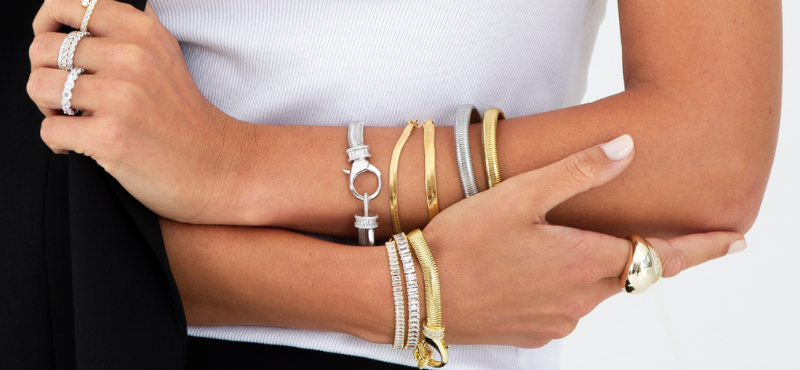The History of Jewelry

Believe it or not, jewelry has been around since the dawn of civilization. From simple adornments made from natural materials to stunning pieces crafted from precious metals and gemstones, jewelry has been used to express personal style and enhance peoples’ appearance for centuries. The history of jewelry is as intricate as the jewelry itself.
The earliest evidence of humans wearing jewelry dates back around 120,000 years ago. Jewelry made from materials such as shells, teeth, and bones has been discovered in archaeological sites all over the world. Hunters believed wearing these adornments would bring them good luck. In ancient times, people would wear jewelry (AKA amulets) to ward off bad luck and illness. Jewelry was considered to hold magical powers. Over time, more durable materials were used including stone, wood, and clay which allowed for more intricate designs to be created.
By 3000 BC, metals began to be used for jewelry making. Gold was a favored material due to its durability and malleability, which allowed artisans to create complex pieces that could retain their shape over time. As human civilization advanced, so too did the techniques used in creating beautiful and ornate pieces of jewelry that continue to inspire us today.
Today, jewelry remains a popular fashion accessory, with women of all ages sporting everything from delicate diamond pendants to dramatic statement pieces. Let's take a look at the history of jewelry, from the earliest cultures through the present day!
Jewelry During The Stone Age

Our fascination with jewelry began thousands of years ago during the Stone Age. Archeological finds have revealed an assortment of necklaces, rings, and other items adorned on humans as far back as 75,000-120,000 years ago. While some pieces were functional and served to hold tools together or keep clothing fastened, more often than not, early jewelry was crafted out of materials like ivory, natural stone, and bones for aesthetic appeal.
It still holds true today that we use jewelry to express our individual style and life story — it is a part of our wardrobe and emotions. So the next time you put on your necklace or ring, remember this millennia-old tradition of wearing special adornments for beauty's sake!
What were some of the first pieces of jewelry?
Jewelry has been around since time immemorial and the earliest pieces were fashioned from materials such as bone, wood, and stone. Over time, those simple jewelry pieces evolved into beautiful art forms that could be worn and enjoyed. While it's amazing to think of the designs and craftsmanship behind these pieces made with primitive materials, it's even more remarkable that they have stood the test of time and can still be seen today. Jewelry just has a timeless appeal that inevitably brings us back in its wake!
People made jewelry from bone, wood, and stone using simple tools such as knives, hammers, and chisels. They would carve intricate designs into the material and polish it to bring out its natural beauty. They also used beads of various materials to string together necklaces or bracelets. Over time, more durable materials were incorporated which allowed for more complex pieces of jewelry with better craftsmanship that could retain their shape over time.
Jewelry During The Bronze Age
During the Bronze Age, metals like copper and bronze were being used to make jewelry. Greece, Anatolia, Canaan and Mesopotamia, and Egypt were four major civilizations during that time.
By the Bronze Age, metals such as copper and bronze were a sign of wealth, status, and sophistication. It is speculated that the advent of these metals revolutionized people's perception of aesthetic beauty around the world! Specialists crafted beautiful and intricate designs to adorn arms, necks, and more to signify prestige.
For those crafting the jewelry, it was a symbol of pride, accomplishment, and skill. Even today we continue to be dazzled by the outstanding craftsmanship present in Bronze Age jewelry. Who knows what mysteries if any await us?
In the Bronze Age, copper and bronze were highly sought-after metals for jewelry making. Copper was the metal of choice for many early civilizations due to its malleability, which allowed artisans to create intricate pieces that could retain their shape over time.
This time period lasted from approximately 3300 BC to 1200 BC. It was the first time people started working with metal. The torc, which was a metal loop, was commonly worn as necklaces and bracelets. Europeans and Romans eventually adopted this style and made it their own. The gorget, on the other hand, was a thicker torc that was worn like a metal collar or necklace. Brooches can also be traced back to the Bronze Age when they were used to fasten coats in the winter.
In ancient Egypt, during this time, everyone wore jewelry — not just those of higher status. Egyptians loved wearing broad-collar necklaces and semi-precious stones. Pharaohs and queens wore pendants, amulets, and other prestigious jewelry to be attractive to their gods. Believe it or not, silver was more widely used than gold jewelry!
The Iron Age Jewelry
Gold and silver became popular materials for jewelry in the Iron Age.
The Iron Age was an exciting time for jewelry as it saw the rise of gold and silver being added to jewelry designs! While these materials had been around for a while before, their popularity shifted throughout the era which saw them become common additions in both fashion and status symbols.
Whether it was threading them through hair or wearing them on fingers, wrists, or other areas of the body, gold, and silver became staples in jewelry making. The Iron Age was certainly a magical time to bring these two beautiful metals into the everyday!
The Middle Ages Jewelry

Jewelers began using enamel to add color to their pieces during the Middle Ages. The quality of glass in Europe was perfected and jewelry wearers were mesmerized by its texture.
In the Middle Ages, jewelers started to truly dazzle us by adding a dash of color to their pieces with enamel. Shiny metal alone wasn't enough. Middle Age jewelers wanted to sprinkle some color into their creations and enamel was the perfect ingredient for that! Whether it was colored metal, glass, or colorful stone mixed in with enameling techniques, these artisans made exquisite jewels that still sparkle today. Jewelry from this era exudes an old-world charm and a timeless elegance that will never go out of style.
Enamel is an ideal material for jewelry due to its vibrant color palette, durability, and versatility. The color palette of enamel is incredibly diverse, ranging from soft pastels to deep jewel tones.
Renaissance Jewelry
Renaissance jewelry is a timeless symbol of beauty and luxury.
This type of jewelry was popularized during the Renaissance period in Europe when artisans began to explore more with bright colors, bold textures, and intricate designs that made their creations stand out from traditional pieces.
Crafted from precious metals and stones like gold, silver, diamonds, pearls, rubies, and sapphire, renaissance jewelry captures the elegance that will never go out of style. With its unique blend of classic sophistication and modern flair, renaissance jewelry continues to be an iconic staple in fashion history!
Modern Jewelry

Modern jewelry is often made from precious metals and stones, but can also be made from more affordable materials like glass or plastic.
Step up your bling game and add a bit of sparkle to your wardrobe with modern jewelry designs! Fashionably crafted from various materials like precious metals, stones, glass, and plastic - you can truly find the perfect piece that fits your unique style. Whether you’re going for a more classic look with diamond studs or a bohemian burst with acrylic rhinestones; finding the ideal accessory to complete any outfit will be easier than ever before!
The dawn of modern jewelry began to arise in the mid-20th century when fashion trends shifted and a wider variety of materials were being used to create unique pieces. This was a major departure from traditional jewelry designs, which relied mainly on precious metals and stones. Innovative designers began to experiment with more playful materials such as glass, plastic, and acrylic to craft their designs.
This era also saw an increase in the amount of creativity present in jewelry making. With the advent of new technologies, artisans could create pieces that went beyond traditional shapes and sizes - opting for contemporary pieces that often featured abstract designs or patterns. Jewelers started to explore further with bright colors, bold textures, and eye-catching designs that made their creations stand out even more.
In addition to the creative design elements being incorporated into modern jewelry, this era also saw an expansion in terms of price points as well. It was now possible for people from all economic backgrounds to access stylish and beautiful pieces without breaking the bank! Affordable fashion jewelry became popular amongst those who wanted to make a statement without spending too much money.
Today's modern jewelers continue to push the boundaries of what constitutes “jewelry” by using even more unique materials such as wood, leather, hemp, resin, and other recycled items. In addition to these innovative materials being used for creating wearable art, technology has also allowed for 3D printing techniques that can bring any design imaginable to life! With these advancements in technology combined with the creativity of today’s jewelers - it is no wonder why modern jewelry is so captivating!

What is the most valuable piece of jewelry in the world?
The most valuable piece of jewelry in the world is the Hope Diamond, a 45.52-carat deep blue-colored diamond that was first discovered in India in 1642. The diamond has an estimated value of over $200 million and is said to be cursed due to its long history of violence, theft, and death.
What was Cleopatra’s favorite gemstone?
Cleopatra, who lived in ancient Egypt, loved Emeralds!
What is the oldest known form of jewelry?
That’s up for debate! But according to an archeologist dig in 2021, 150,000-year-old snail shell beads in Morocco were found to be the world’s oldest form of jewelry













